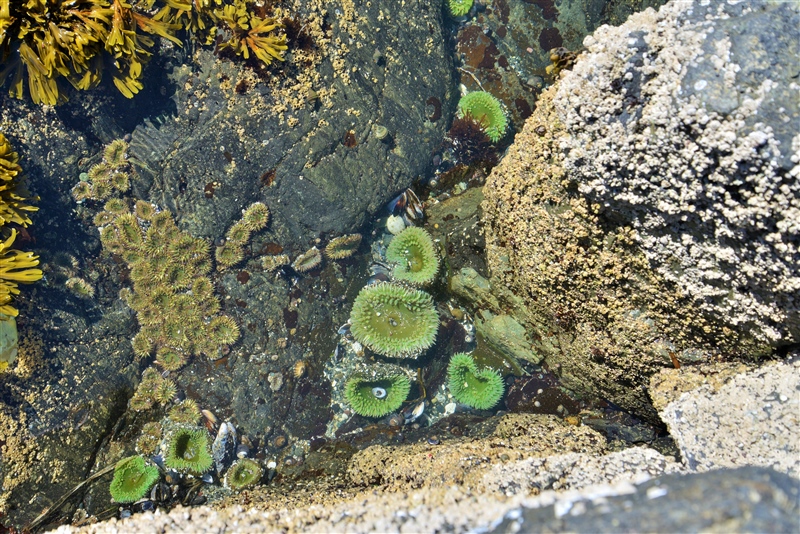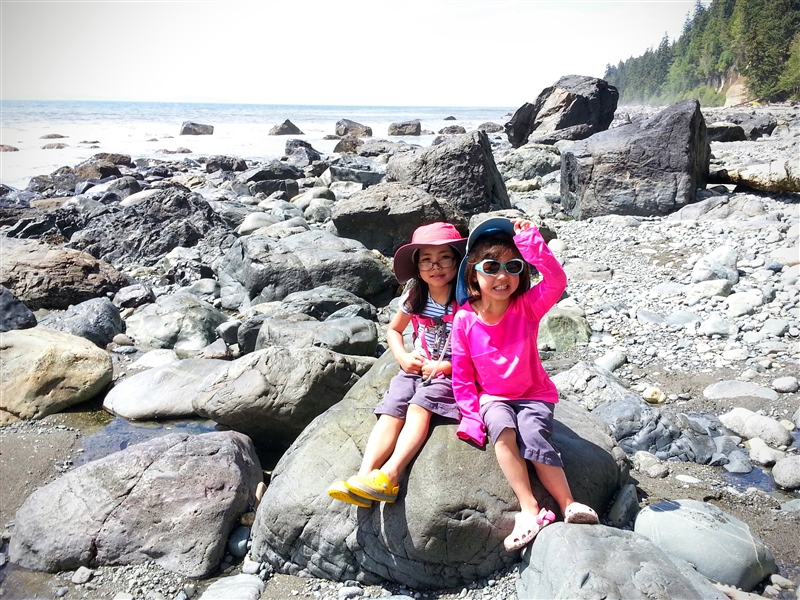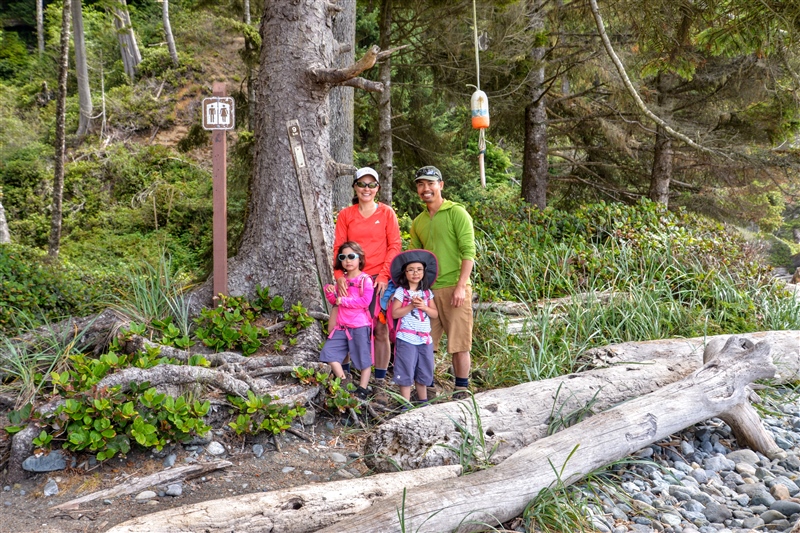6.5K
The Juan de Fuca Marine Trail is a weekend warrior’s paradise, but also makes a desirable family backpacking destination. With suspension bridges, rope swings, caves, beautiful beaches, whale watching and waterfalls, there is fun for everyone. Further, various access points make it possible to choose your own adventure. Instead of trekking 47 km, you may start at China Beach Day Use Area and do an overnighter at Mystic Beach (4 km return), or do a longer hike to Bear Beach (18 km return). The accessibility of the trail is a definite advantage over the more popular West Coast Trail. On the Juan de Fuca Trail, you do not need to take a ferry to the trailhead, drive hours down a rough logging road, make reservations months in advance, or take a mandatory orientation (though some hikers could benefit from one).
Our adventure took us to Mystic Beach, Bear Beach, Sombrio, and Botanical Beach. In total, my girls (4 & 6 years old) hiked over 20 kilometres! We look forward to doing the whole trail when they’re bigger.
Table of Contents
Juan de Fuca Marine Trail Trip Report
China Beach Day Use to Mystic Beach (2 km hike)
The trail to Mystic Beach (2 km) is in great shape as this area gets a lot of foot traffic. Once you hit the beach you’ll see why this is such a popular dayhike and overnight camping spot! The suspension bridge was our favorite part of the hike.
Mystic Beach (just past the 2 km marker)
This gorgeous sand and pebble beach has a cave, rope swing, and two small waterfalls. Either waterfall makes a great shower! Collect some drinking water while you’re at it!
Our most memorable moments of camping at Mystic Beach include swinging on the rope swing, seeing a pod of orcas frolic through Juan de Fuca Strait, and checking out rock art in the cave.Arrive early to get a good spot as there are limited sites on the beach (and there are no forest sites).
 |
| Mystic Beach |
 |
| Mystic Beach Cave |
 |
| Mystic Beach Rope Swing! |
 |
| View from the Tent on Mystic Beach |
 |
| Beachside Breakfast |
Mystic Beach to Bear Beach (7 km hike)
This part of the trail was a little rougher and had more challenges and hazards – cliffs, slippery wooden structures, and a couple sketchy, steep sets of “stairs”. We kept the kids close as there are many things to fall off of! The trail was a bit sketchy in the pouring rain, but when we hiked out two days later (after a full day of sunshine), it was far easier. It’s amazing what a difference the weather makes. The trickiest part was the descent down to Bear Beach, but we took our time and made it down safely.
 |
| Munchkins in the Mist |
 |
| Hiking to Bear Beach, Juan de Fuca Marine Trail |
 |
| Descending to Bear Beach |
Bear Beach (at the 9 km marker)
Bear Beach is a long, rocky beach with a stream, waterfall, and opportunities for wildlife viewing. While we never saw Bear Beach’s namesake, we did see several seals and otters in the kelp beds. I imagine there must be some amazing fishing in the area! Several campsites are spread out over a long area and there are also a handful of forested campsites near the creek. If the weather is foul, camp in the forest to take shelter from the wind.
While there are a few patches of sand, the beach is mostly rocks, so it isn’t the best sand castle building beach. Nevertheless, we had plenty to do and spent most of our time beachcombing and splashing in the stream. Since the stream flows quite quickly, you do not have to walk too far upstream to get drinking water. If you need to clean yourself up, the stream is the place (but do it close to the sea / downstream of people collecting drinking water) as the waterfall is surrounded by deadfall.
The stretch from Bear Beach to Sombrio is the most strenuous section of the trail, so we hiked back to our car and drove to the Sombrio Beach Trailhead.
Sombrio is a popular surfing spot and has three camping options: West Sombrio, Main Sombrio, and East Sombrio. Since the girls were tuckered out from the 9 km hike back from Bear Beach, we opted for the West Sombrio, the closest campground, 500 metres from the parking lot. Sites were in the forest on tent pads. Beach camping is available at Sombrio Beach East.
Highlights of our stay included swinging on the rope swing and watching a humpback whale cruise through the strait and “wave” at us. For a fun day trip, hike to the Loss Creek Suspension Bridge, the longest bridge on the trail (about 100 feet long and 100 feet high). We plan to do this next time!
Highlights of our stay included swinging on the rope swing and watching a humpback whale cruise through the strait and “wave” at us. For a fun day trip, hike to the Loss Creek Suspension Bridge, the longest bridge on the trail (about 100 feet long and 100 feet high). We plan to do this next time!
 |
| Sombrio Beach Rope Swing |
Botanical Beach
After a restful day at Sombrio, we headed up the highway to Botanical Beach. Known for its rich intertidal life, Botanical Beach is a popular tide pool viewing location. Be sure to go at low tide for the best viewing opportunities and avoid touching or stepping on little critters. There are some pretty hikes around the bay, and if you get hungry, pop into Port Renfrew for a bite at the Coastal Kitchen Cafe, Tom’s Home Cooking (THC Diner), or Port Renfrew Hotel. There is also a general store where you can restock provisions.
If you have time, check out old growth giants at Avatar Grove!
 |
| Botanical Bay |
 |
| Botanical Bay |
Planning Your Trip
- All campsites on the JdF are first come, first served. Self register at the trailhead – be sure to keep one payment stub on your dash and one with you.
- Weekends tend to be quite busy, especially at Mystic Beach and Sombrio, so get an early start to ensure you get a campsite. If your schedule is flexible, start midweek.
- When camping on the beach, ensure you pitch your tent above the high tide line. In the forest campgrounds, you must use the tent pads.
- Peak season is July and August because the weather is best then. Some hikers have had success in September but outside of these months, expect a lot more precipitation.
- While there is no age restriction on the Juan de Fuca (JdF) trail, I advise section hiking the moderate sections if your children are under the age of 10.
- According to parks information posted in the outhouses, Vancouver Island has the highest concentration of bears of cougars in the world! For tips on being bear aware, please see this post.
- Bring a lot of treats for motivation!
Hazards
Tides – be sure to camp above the high tide line and observe tides when hiking along the shore. Buoys mark trail access points, but where there are cliffs, there is no way off the beach. Plan your route accordingly.
Cliffs – no fences to prevent falling
Cliffs – no fences to prevent falling
Wooden structures such as bridges, logs, and ladders are slippery when wet. Wear good footwear and hold little ones’ hands.
Location
The Juan de Fuca Marine Trail is located on the southwest side of Vancouver Island between French Beach Provincial Park and Port Renfrew.The Juan de Fuca Marine Trail is doable with kids if you stick to the easy sections! Choose your own adventure and stay one night or many!
Related Links
All The Small Things (How we made the most of the pouring rain on the Juan de Fuca Marine Trail)
Family Backpacking 101
Family Backpacking 101
Leave No Trace Fails & Remedies – how to dispose of dishwater properly & more










2 comments
Super excited to find your website! And this post in particular, as our family of 5 is heading out to do the Juan de Fuca Trail in a few weeks, having never done any camping on the west coast before. I have a question for you.
We too live in Calgary, and we all have down bags because most of our camping is in the mountains. Some people say we need to get synthetic bags for our trip. Others say that down is best but takes more work to care for. Since outfitting our entire family with a second set of bags is obviously a pricey endeavor as well as going against our minimalist aspirations (we don't have a large storage space), I want to make sure that we are really making the best choice. I would love to hear your opinion! Thanks so much
I'm sorry I missed this! We brought 3 down sleeping bags (hubby's and kids') and one synthetic bag (that I had bought for the West Coast Trail). We prefer down as it is so light and compressible and I really feel that if your sleeping bag is wet – synthetic or not – you are in trouble, so we take precautions to keep them dry: use waterproof stuff sacks, choose campsite carefully (level, remove sharp objects from ground) & use tent footprint, and always peg the fly out properly to keep water draining off the tent. Leaving the vents partially open to reduce condensation in the tent helps too. I hope you had a great trip!!!!
Comments are closed.